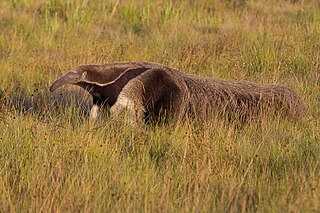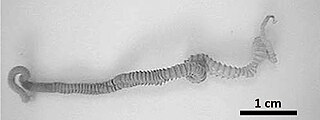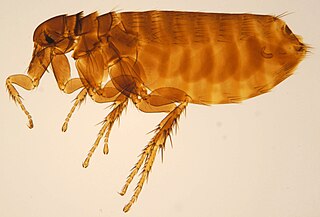
Parasitism is a close relationship between species, where one organism, the parasite, lives on or inside another organism, the host, causing it some harm, and is adapted structurally to this way of life. The entomologist E. O. Wilson characterised parasites as "predators that eat prey in units of less than one". Parasites include single-celled protozoans such as the agents of malaria, sleeping sickness, and amoebic dysentery; animals such as hookworms, lice, mosquitoes, and vampire bats; fungi such as honey fungus and the agents of ringworm; and plants such as mistletoe, dodder, and the broomrapes.

Flea, the common name for the order Siphonaptera, includes 2,500 species of small flightless insects that live as external parasites of mammals and birds. Fleas live by ingesting the blood of their hosts. Adult fleas grow to about 3 millimetres long, are usually brown, and have bodies that are "flattened" sideways or narrow, enabling them to move through their hosts' fur or feathers. They lack wings; their hind legs are extremely well adapted for jumping. Their claws keep them from being dislodged, and their mouthparts are adapted for piercing skin and sucking blood. They can leap 50 times their body length, a feat second only to jumps made by another group of insects, the superfamily of froghoppers. Flea larvae are worm-like, with no limbs; they have chewing mouthparts and feed on organic debris left on their hosts' skin.

Tunga penetrans is a species of flea also known as the jigger, jigger flea, chigoe, chigo, chigoe flea, chigo flea, nigua, niknik, sand flea, or burrowing flea. It is a parasitic insect found in most tropical and sub-tropical climates. In its parasitic phase it has significant impact on its hosts, which include humans and certain other mammalian species. A parasitical infestation of T. penetrans is called tungiasis. Jiggers are often confused with chiggers, a type of mite. Jiggers are native to Central and South America, and have been introduced to sub-Saharan Africa.
The echidna flea is the larger of two species of flea commonly found on the short-beaked echidna. It is monotypic, that is, the only species in the genus. This flea reaches 4 millimetres in length and has been claimed to be the world's largest flea. This statement is in error as the world's largest flea is known to be the mountain beaver flea which can be as large as 12 millimetres in length.

The Streblidae are a family of flies in the superfamily Hippoboscoidea, and together with their relatives the Nycteribiidae, are known as bat flies. They are winged or wingless ectoparasites of bats, and often have long legs. They appear to be host-specific, with different species of bat flies occurring only on particular species of bat hosts, sometimes with multiple species of flies sharing a host bat.

Nannochoristidae is a family of scorpionflies with many unusual traits. It is a tiny, relict family with a single extant genus, Nannochorista, with eight species occurring in New Zealand, southeastern Australia, Tasmania, Argentina and Chile. Due to the group's distinctiveness from other scorpionflies, it is sometimes placed in its own order, the Nannomecoptera. Some studies have placed them as the closest living relatives of fleas. Most mecopteran larvae are eruciform, or shaped like caterpillars. Nannochoristid larvae, however, are elateriform, and have elongated and slender bodies. The larvae are aquatic, which is unique among mecopterans. The larvae are predatory, hunting on the beds of shallow streams, primarily on the larvae of aquatic Diptera like chironomids.

Boreidae, commonly called snow scorpionflies, or in the British Isles, snow fleas are a very small family of scorpionflies, containing only around 30 species, all of which are boreal or high-altitude species in the Northern Hemisphere.

The dwarf dog-faced bat is a species of free-tailed bat from South America. It is found in Argentina, Bolivia, Brazil, Colombia, Ecuador, Guyana, Peru, Paraguay and Uruguay, typically at lower elevations. It is one of two species in the genus Molossops, the other being the rufous dog-faced bat. Three subspecies are often recognized, though mammalogist Judith Eger considers it monotypic with no subspecies. It is a small free-tailed bat, with a forearm length of 28.9–32.5 mm (1.14–1.28 in) and a weight of 5–8 g (0.18–0.28 oz); males are larger than females. It is brown, with paler belly fur and darker back fur. Its wings are unusual for a free-tailed bat, with exceptionally broad wingtips. Additionally, it has low wing loading, meaning that it has a large wing surface area relative to its body weight. Therefore, it flies more similarly to a vesper bat than to other species in its own family. As it forages at night for its insect prey, including moths, beetles, and others, it uses two kinds of frequency-modulated echolocation calls: one type is to navigate in open areas and to search for prey, while the other type is used for navigating in cluttered areas or while approaching a prey item.

Akodon spegazzinii, also known as Spegazzini's akodont or Spegazzini's grass mouse, is a rodent in the genus Akodon found in northwestern Argentina. It occurs in grassland and forest at 400 to 3,500 m above sea level. After the species was first named in 1897, several other names were given to various populations now included in A. spegazzinii. They are now all recognized as part of a single, widespread and variable species. Akodon spegazzinii is related to Akodon boliviensis and other members of the A. boliviensis species group. It reproduces year-round. Because it is widely distributed and common, Akodon spegazzinii is listed as "least concern" on the IUCN Red List.

Akodon caenosus is a rodent in the genus Akodon found in northwestern Argentina and south-central Bolivia. Since its description in 1918, it has been alternatively classified as a separate species or a subspecies of Akodon lutescens. The species Akodon aliquantulus, described from some very small Argentine specimens in 1999, is now recognized as a synonym of A. caenosus.

The human flea – once also called the house flea – is a cosmopolitan flea species that has, in spite of the common name, a wide host spectrum. It is one of six species in the genus Pulex; the other five are all confined to the Nearctic and Neotropical realms. The species is thought to have originated in South America, where its original host may have been the guinea pig or peccary.

Anteaters are the four extant mammal species in the suborder Vermilingua, commonly known for eating ants and termites. The individual species have other names in English and other languages. Together with the sloths, they are within the order Pilosa. The name "anteater" is also commonly applied to the unrelated aardvark, numbat, echidnas, and pangolins, although they are not closely related to them.

Gigantorhynchus is a genus of Acanthocephala that parasitize marsupials, anteaters, and possibly baboons by attaching themselves to the intestines using their hook-covered proboscis. Their life cycle includes an egg stage found in host feces, a cystacanth (larval) stage in an intermediate host such as termites, and an adult stage where cystacanths mature in the intestines of the host. This genus is characterized by a cylindrical proboscis with a crown of robust hooks at the apex followed by numerous small hooks on the rest of the proboscis, a long body with pseudosegmentation, filiform lemnisci, and ellipsoid testes. The largest known specimen is the female G. ortizi with a length of around 240 millimetres (9.4 in) and a width of 2 millimetres (0.08 in). Genetic analysis on one species of Gigantorhynchus places it with the related genus Mediorhynchus in the family Gigantorhynchidae. Six species in this genus are distributed across Central and South America and possibly Zimbabwe. Infestation by a Gigantorhynchus species may cause partial obstructions of the intestines, severe lesions of the intestinal wall, and may lead to death.

Ceratophyllus gallinae, known as the hen flea in Europe or the European chicken flea elsewhere, is an ectoparasite of birds. This flea was first described by the German botanist and entomologist Franz von Paula Schrank in 1803.

Pulex is a genus of fleas. It comprises seven species. One is the human flea, and five of the others are confined to the Nearctic and Neotropical realms.

Huilatherium is an extinct genus of leontiniid, a group of hoofed mammals belonging to the order Notoungulata, that comprises other South American ungulate families that evolved in parallel with some mammals of the Northern hemisphere. The leontiinids were a family of herbivorous species comprising medium to large browsers, with relatively short skulls and robust limbs, somewhat similar to their relatives, the best known toxodontids.
Uquiasaurus is an extinct genus of iguanian lizards represented by the type species Uquiasaurus heptanodonta from the Late Pliocene of Argentina. Uquiasaurus was first described in 2012 on the basis of isolated snout and jaw bones within the Uquía Formation, the namesake of the genus. These bones were preserved in a midden of predatory bird pellets and are part of a microvertebrate assemblage that includes the bones of rodents, marsupials, frogs, birds, and other lizards, one of the few to document the mixing of North and South American faunas during the Great American Interchange. Phylogenetic analysis indicates that Uquiasaurus is part of a clade of iguanians that includes the living families Liolaemidae, Leiocephalidae, and Tropiduridae. The status of U. heptanodonta as a valid taxon was contested by Scanferla & Díaz-Fernández (2023), who reinterpreted the type series of this species as a fossil bone assemblage composed by more than one species of Liolaemus. Below is a cladogram from Daza et al. (2012) showing its phylogenetic relationships:
Hectopsylla is a genus of fleas in the family Hectopsyllidae that parasitize non-volant mammals, birds, and bats. The genus comprises thirteen species, six of which were described in whole or part by Karl Jordan between 1906–1942. Two of the species in Hectopsylla, H. psittaci and H. pulex, go under common names, with H. psittaci identified as the sticktight flea and H. pulex identified as the chiggerflea. Hastritter and Méndez (2000) consider the genus Rhynchopsyllus a junior system of the genus.
Astegotherium is an extinct genus of xenarthran, belonging to the family Dasypodidae. It lived from the Early to the Middle Eocene, and its fossilized remains are found in Argentina.













